As an eye care professional, you’re entrusted with one of the most precious human senses – vision. Selecting the right tonometer for your practice is an essential step towards maintaining your patients’ optic health. A tonometer, after all, is a vital tool in your arsenal —it helps accurately measure intraocular pressure, making it indispensable when it comes to glaucoma diagnosis and monitoring. Yet with an array of options in the market, choosing the perfect fit can feel overwhelming. We’re here to help navigate you through this important decision.
“Picking the right tonometer is about much more than just accuracy — it’s about aligning with your practice’s needs and ensuring the comfort and care for your patients.”
Join us as we guide you through the essential points to consider while making your selection, ensuring you choose a tonometer that will serve your practice in the long run. From considerations about price and brand credibility to ease of use and maintenance demands, we’ll cover it all. Let’s get started!
Choosing just the right tonometer for your eye care practice becomes an easier task when the variety of available types is well-understood. From ancient inventions like the Maklakov tonometer to more modern creations such as the Phosphene tonometer, each variant serves a distinct purpose. While some may be noted for their precision, others might be more suitable for individual client comfort or specific eye conditions.
The Goldmann tonometer, for instance, has earned popularity in the field due to its impressive accuracy. Likewise, the non-contact tonometer is the go-to choice for practices aiming for a more patient-friendly experience, as it measures Intraocular Pressure (IOP) without requiring physical contact with the eye. Alternatively, the Pascal Dynamic Contour Tonometer (DCT) offers a unique approach to tonometry, analyzing the eye’s contour, which can aid in cases involving corneal irregularities.
With technological advancements at our fingertips, it’s now possible as never before to select the tonometer best suited for each patient. The sheer variety reflects the diversification in the ways to measure IOP, such as the applanation tonometer, Dynamic contour tonometer, and Indentation tonometer. Remember, selecting the right device can make a significant difference in both the accuracy of the results and the comfort of your patient.
The continuous evolution of tonometry includes developments like continuous IOP monitoring devices, impact tonometers, vibrational tonometers, and even self-tonometers. These offer the prospect of improved, streamlined monitoring processes, potentially enhancing patient care and treatment plans.
We are privileged to be a part of an era where options abound, bringing the best possible eye care services to our patients. After all, tonometry is about more than just the tonometers themselves—it’s about figuring out the best fit for our practice and patient needs, while ensuring the highest accuracy, efficiency and comfort. Keeping up-to-date with the latest advancements in tonometry can keep you at the forefront of excellent patient care.
Undeniably, the forward march of progress in optometry presents exciting opportunities for delivering enhanced eye care. In our context, that means selecting the optimal tonometer for our patients’ distinct needs. Remarkably, the invention wheel in the field of tonometry has been turning incessantly, leading to a broad selection of devices, each with varying clinical applications.
The key is to understand and embrace these technological advancements, as they serve the dual purpose of meeting patient needs and ensuring accurate measurements.
Nine notable tonometer types have been detailed, including the reliable Goldmann tonometer, the practical Tono-Pen, Perkins tonometer, the advanced Ocular Response Analyzer, non-contact tonometer, the accurate pneumatonometer, the portable I-care rebound tonometer, Pascal dynamic contour tonometer (DCT), and the innovative Phosphene tonometer. Each1 offers unique benefits, making them suited to specific clinical needs.
For instance, the dynamic bi-directional applanation tonometer proves notably useful for patients with glaucoma due to its ability to provide accurate and repeatable results. In contrast, the Goldmann applanation tonometer, which holds its position as the golden standard of tonometry, offers undeniable versatility for all patients.
Additionally, miscellaneous tonometers like continuous IOP monitoring devices, self-tonometer, impact tonometer, vibrational tonometer, and newer entrants like Transpalpebral T and Disposable tonometer, are also increasing the selection pool with their unique applications. With such a wealth of options, you are guaranteed to find the perfect tonometer that fits your eye care practice’s needs and preferences.
The history of tonometry plays a significant part in informing our choices today. The Goldmann applanation tonometer, for example, continues to be the worldwide standard bearer in tonometers because of its enduring accuracy over many years. Its role as a reference point in comparison with other devices shows the importance of getting our tonometer choices right based on patients’ needs, reliability, and accuracy.
Part of this storied history is the Schiotz tonometer, introduced way back in 1905. It’s an example of an Indentation Tonometer, demonstrating how different researchers have contributed to the evolution of tonometers over the years.
Ultimately, our commitment to eye care and enhancing patient experiences should be mirrored in our tonometer selection. With the advances in technology, we are better equipped to choose the right tonometer, thereby ensuring that our practice meets the gold standard it deserves.
It’s a fascinating journey, moving through the world of tonometers. The range is broad and diverse, with advanced technological developments granting devices tailored to specific needs. Understanding this may seem daunting, but fear not! The most crucial factor to remember is the specific requirements of your practice and patient demographics.
Among the tonometers, you’ll find options like the Goldmann Tonometer, known as the gold standard in tonometry. Its popularity stems from its accurate and reliable measurements. If your practice requires adherence to the most proven, reliable methods, it makes an excellent choice. Schiotz Tonometer, a pioneer device introduced in 1905, is an example of an Indentation Tonometer. Both provide consistent results, though they might not come with the latest bells and whistles.
If your focus drifts towards versatility, a dynamic contour tonometer or an I-Care rebound tonometer might be a perfect match. These devices have adjustable settings and can adapt to different clinical applications, providing a higher degree of flexibility in comparison to their counterparts.
The evolution of tonometry led to the creation of specialized tonometers like the Ocular Response Analyzer, pneumatonometer, and even self-tonometers. Such devices are designed for unique applications and can provide you with precise results under specific circumstances. However, their application might be limited and should be carefully considered based on the specific needs of your practice.
Suffice to say, the choice comes down to your individual needs and what you value most in tonometry: versatile devices adaptable to various situations, or specialized tonometers designed for a particular purpose. Remember, there’s no one-size-fits-all answer in this field – your practice’s unique patient demographic and needs should always guide your tonometer selection.
Once you’ve assessed the type of tonometer – be it applanation, indentation, or dynamic contour – it’s time to cross-check this with your practice’s needs. Goldmann applanation tonometry might be excellent for general use, but the pneumatonometer might benefit you if you frequently deal with corneal abnormalities.
Accuracy is paramount, and thankfully, most modern tonometers, such as the Pascal Dynamic Contour Tonometer, show good reproducibility with minimal inter & intraobserver variations. Balancing the accuracy of measurements with the suitability to your patients will ensure you make a choice that truly benefits your practice.
Remember, the history of tonometry is broad and rich, and researchers have developed various types of tonometers over time. Whether your practice prefers the tried-and-true or the cutting-edge, there is a tonometer out there that will meet your needs perfectly.
What is the current benchmark in tonometry? The Goldmann applanation tonometer (GAT) is widely recognised as the gold standard due to its recurring use in numerous clinical research studies. This doesn’t mean it’s the only choice, but it’s an important reference. Are there any modern alternatives to traditional tonometers? Yes, indeed. In addition to conventional devices like the Maklakov and Planometer tonometers, there are now continuous IOP monitoring devices, self-tonometers, and even disposable tonometers. New technology continues to innovate in this field. How important is the distinction between indentation, applanation, and non-contact tonometers? It can play a critical role in your selection. These differences not only affect the method of IOP measurement but also patient comfort and suitability. It’s important to know your practice and patients to make the best decision. What factors should influence my tonometer selection? Apart from the key function of accurate IOP measurement, consider factors like patient comfort, versatility of use, latest advancements, and the specific needs of your practice. The perfect tonometer isn’t universal—it’s what best fits your unique context. What are some newer tonometers I should look into? Among the latest advancements, the Transpalpebral T and Disposable tonometer have been of interest. Continuous monitoring devices and self-tonometers also offer unique, patient-focused options. However, as always, their effectiveness should be compared against the Goldmann benchmark.
In conclusion, the journey to selecting the ideal tonometer for your eye care practice involves detailed considerations of technological advancements, clinical applications, versatility, and accuracy. Still rooted in the reliability of the Goldmann tonometer, you now have the privilege to navigate through a wide array of advanced tonometers.
| Tonometer Type | Function | Key Advantages | Potential Drawbacks |
|---|---|---|---|
| Goldmann Tonometer | Used for IOP measurement as a reference standard | Esteemed accuracy and widespread clinical research background | Less mobile, expensive and requires trained professional |
| Tono-Pen | Portable, handheld device for IOP measurement | Great convenience in mobility, less expertise required | Slightly less accuracy compared to Goldmann |
| Non-Contact Tonometer | Measurement of IOP without physical touch | More comfort to patients, low expertise required | Less accuracy and reliability |
| I-Care Rebound Tonometer | Measures IOP through a rebounding probe | Overall comfort for patients (no anaesthesia), easy use | May slightly underestimate the IOP |
| Pascal DCT | Measures IOP with minimal tissue distortion | More accurate reading with variable corneal biometrics | Requires a high-level of expertise, expensive |
Each option brings its unique strengths, whether it’s patient comfort, continuous monitoring or specialized capabilities. The evolution of tonometer tech opens up opportunities to provide enhanced, personalized patient care while still upholding the highest standards of clinical accuracy.
VISIT OUR SHOP
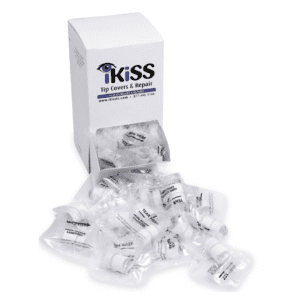
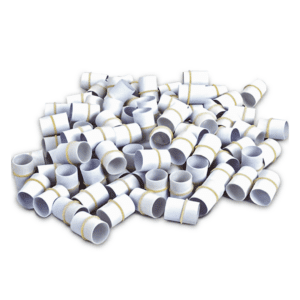
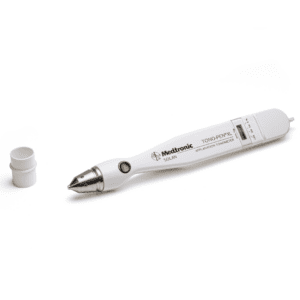
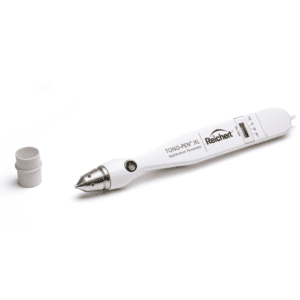
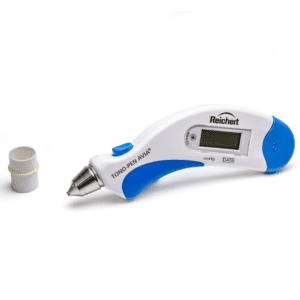
iKiSS is the go-to provider for top-quality refurbished Tono-Pen® Tonometers, Tono-Pen AVIA® Tonometers, Slit Lamps, and Phoropters, offering substantial savings of up to 40%.